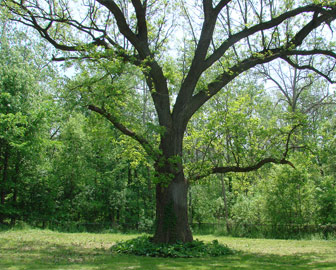
- A Society of Royal Oaks -
Bur Oak Tree
Henry Ford Estate, Fair Lane
Dearborn, Michigan

“He who owns a veteran Bur Oak owns more than a tree. He owns an historical library, and a reserved seat in the theatre of evolution. To the discerning eye, his farm is labeled with the badge and symbol of the prairie war (with the forest).”
- Aldo Leopold, pioneer wildlife ecologist.
- Aldo Leopold, pioneer wildlife ecologist.
The Bur Oak (Quercus macrocarpa michaux) that is located on what is now called the Henry Ford Estate is estimated to be over 300 years old and stands as a witness to the sweeping changes that have occurred on the site: the flourishing Native American settlements; the near clearing of the land by 19th-century farmers; the purchase of the site by industrialist Henry Ford, and the development of the property by celebrated landscape architect, Jens Jensen. The Bur Oak became the center of the estate's vegetable garden during the Ford family tenure, and though the garden has long since vanished, the oak remains.
For today’s visitor, the Bur Oak has become an essential link to connect with the region's past, to learn about pre-and early-settlement land use as well as the Ford’s enjoyment of the site and Jensen's conscientious integration of the existing tree into his designed landscape. Though the species is native to Michigan, there are relatively few remaining Bur Oaks of this age in the southeast portion of the state. The tree, severely damaged by lightening strikes over the years, has become a powerful symbol of survival.
Courtesy Henry Ford Estate, Fair Lane